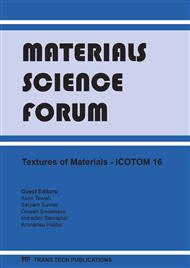p.566
p.570
p.574
p.578
p.585
p.591
p.595
p.599
p.603
Abnormal Growth Mechanisms of Goss Grains in Grain-Oriented Electrical Steels
Abstract:
The possible mechanisms concerning abnormal growth of Goss grains in grain oriented electrical steels were investigated. The density of inhibitor particles near sheet surface, where the Goss grains located, was lower than that in center layer before secondary recrystallization, and the grains near surface could grow more easily because of reduced pinning effect. Few Goss grains could survive the growth competition and reach the sheet surface, after which the inhibitor particles inside the Goss grains coarsened slower. The phenomenon resulted in easy growth of the Goss grains at the expense of smaller neighboring grains while they could hardly be consumed by larger neighboring grains during the high temperature secondary recrystallization. Very large final size of the Goss grains was then obtained. The mechanisms were discussed based on the hot rolling characteristics and the elastic anisotropy of the ferrite matrix.
Info:
Periodical:
Pages:
585-590
Citation:
Online since:
December 2011
Authors:
Price:
Сopyright:
© 2012 Trans Tech Publications Ltd. All Rights Reserved
Share:
Citation:


